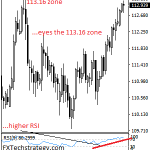One of the big side effects of the low interest rate quantitative easing policies of central banks is that by lowering long term interest rates for governments they also lower long term interest rates for their corporates. This means that it becomes tempting for corporations to do some “financial engineering” – namely issue debt to buy back their shares. In the short term, this can raise the earnings per share and hence make companies look more profitable to shareholders. But there is no such thing as a “free lunch.” In the longer term, this means that companies have a higher debt to equity ratio which makes them more vulnerable to a rise in interest rates down the road as more of their profits will have to be devoted to paying debt holders leaving less for equity holders. It also increases the risk for shareholders as the risk of bankruptcy increases. In the figure below we can see the increasing role of debt financed buybacks compared to normal capex and investment, as the green line departs from the red line by ever increasing amounts for the S&P companies.

Then on the diagram below we can see the increase in debt to total assets for the S&P 1500 companies. This is fine as long as interest rates for corporates remain low but makes them increasingly vulnerable to an interest rate rise.

As indicated by the dashed line corporate indebtedness is now well above the highs recorded in 1999 and 2009 suggesting that US corporations are taking advantage of low interest rates to issue more and more debt to total assets. This may present significant dangers if a recession comes along as this debt will still need to be serviced and shareholders can be expected to take a big hit in the way of lower dividends and/or a fall in share prices to reflect the lower levels of return on equity.












Leave A Comment